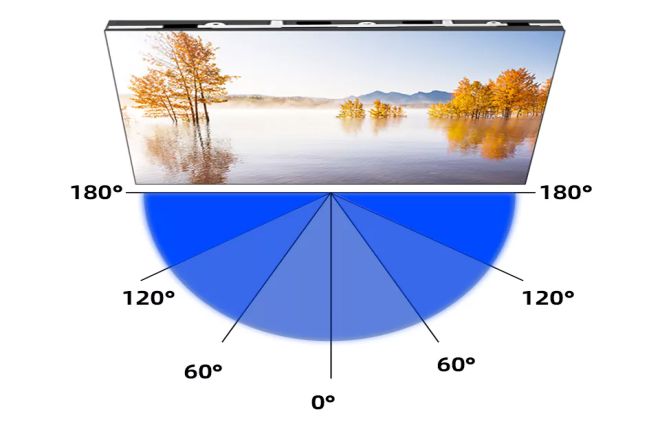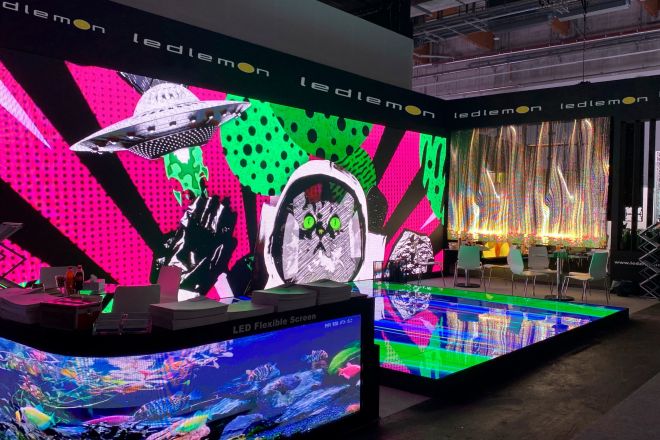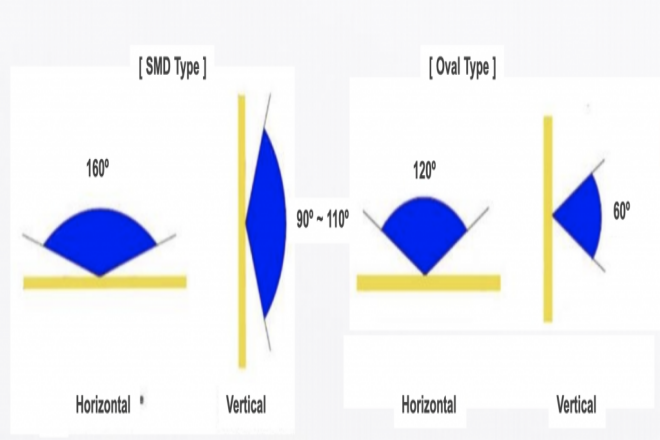序章

実際の応用では LED表示同じLEDディスプレイなのに、なぜ観客の視聴体験はシーンによって大きく異なるのか?という疑問に直面するかもしれません。その中でも、視点の影響は無視できません。
では、LEDのパースペクティブはどのように定義されるのでしょうか?また、どのように調整すればよいのでしょうか?この記事ではその答えをご紹介します。
1. LEDディスプレイの視野角はどのくらいですか?
の 視野角 LEDディスプレイの視野角とは、ユーザーが画面上のすべてのコンテンツを様々な方向から明瞭に観察できる角度範囲を指します。この角度範囲には通常、水平方向と垂直方向の両方が含まれます。具体的には、水平視野角はLEDディスプレイの垂直法線(つまり、LEDディスプレイの中央にある垂直の仮想線)を基準とします。
法線の左側または右側の特定の角度範囲内であれば、ユーザーは表示された画像を正常に見ることができます。同様に、垂直視野角は水平方向の法線を基準とし、上下方向に一定の角度範囲を持ちます。
つまり、画面を様々な方向から見ると、画面上のコンテンツがはっきりと見える角度の範囲のことです。この範囲には、左から右、そして上から下の2つの方向が含まれます。テレビやパソコンの画面を見るときと同じように、横に立ったり、画面の横から見たりすると、画面上のコンテンツがはっきりと見えないことがあります。これは視野角の制限によるものです。
LEDディスプレイの視野角は、主にLEDランプビーズの実装方法と画面を見る距離によって決まります。一般的に、視野角が広いほど、様々な角度から見ても画面の内容が鮮明になります。しかし、視野角がある程度大きくなると、画面上の内容がぼやけることがあります。
LED ディスプレイを選択する際、特に屋外の看板、スタジアム、会議室などの特定の状況では、視野角が非常に重要です。これらの場所では、人々がさまざまな方向から画面を見る可能性があるため、視野角の大きさが特に重要になります。
視野が小さすぎると、画面の横や上に立っている人は画面上のコンテンツをはっきりと見ることができず、視聴体験に影響を及ぼします。
2. 視野角は LED ディスプレイの表示にどのような影響を与えますか?

視野角はLEDディスプレイの表示に大きな影響を与えます。つまり、視野角は、LEDディスプレイを様々な方向から見たときに、画面の内容を明瞭に見ることができる角度の範囲を決定します。具体的には、視野角はLEDディスプレイの表示に以下の側面で影響を与えます。
- 視聴体験:
視野角が広いほど、LEDディスプレイを様々な角度から鑑賞する際の体験が向上します。視野角が不十分な場合、スクリーンの横や上に立つ人は画像がぼやけたり歪んだりして見え、鑑賞効果に影響を与えます。
- 画質性能:
視野角の大きさもLEDディスプレイの画質性能に影響を与えます。視野角が広くなると、画面上のピクセル間の距離が広がり、画像解像度が低下し、画質の鮮明さに影響します。さらに、視野角が広すぎると色の歪みが生じ、画像の色彩性能にも影響を及ぼします。
- アプリケーションシナリオの適応性:
LEDディスプレイの視野角に対する要件は、アプリケーションシナリオによって異なります。例えば、屋外広告板などの公共の場では、歩行者が様々な角度から広告コンテンツを鮮明に視認できるよう、より広い視野角が必要です。
会議室などの屋内では、観客がスクリーンに近いため、遠近感に対する要求は比較的小さくなります。そのため、LEDディスプレイを選択する際には、実際の使用シナリオに応じて適切な視野角を決定する必要があります。
3. LED ディスプレイの視野角に影響を与える要因は何ですか?

LED ディスプレイの視野角に影響を与える主な要因は次のとおりです。
LEDランプビーズの梱包方法: LEDランプビーズのパッケージング方法は、LEDディスプレイの視野角を決定します。一般的に、パッケージング方法が高度であるほど、LEDランプビーズの発光角が大きくなり、LEDディスプレイ画面の視野角も大きくなります。
LEDチップの品質: LEDチップの品質もLEDディスプレイの視野角に影響を与えます。高品質のLEDチップは通常、発光効率が高く、発光性能が安定しているため、より広い視野角を提供します。
スクリーンの表面平坦度: LEDディスプレイの表面の平坦性も視野角に影響します。画面の表面に凹凸があると、異なる角度から見たときに画像が歪んだり、歪んだりして視野角が狭くなることがあります。
視聴距離: 視聴距離はLEDディスプレイの視野角にも影響します。一般的に、視聴距離が長いほど、より大きな視野角が必要になります。したがって、LEDディスプレイを選択する際には、実際の視聴距離に応じて適切な視野角を決定する必要があります。
画面の明るさ: 画面の明るさも視野角に影響します。一般的に、LEDディスプレイの明るさが高いほど、視野角も広くなります。十分な明るさがあれば、広い角度から見ても良好な画像の鮮明さを維持できるからです。
4. LEDディスプレイの視野角を改善するための対策
- LEDビーズのパッケージを最適化:
LEDランプビーズのパッケージング方法を改善し、より高度なパッケージング技術を採用することで、LEDランプビーズの発光角度を拡大します。これにより、LEDディスプレイの視野角が効果的に拡大され、視聴者は様々な角度からより優れた視聴体験を得ることができます。
LEDビーズを小さな電球に例えてみましょう。パッケージング方法を改良することで、小さな電球はより広い範囲を照射できるようになり、より多くの人が画面上のコンテンツを見ることができるようになります。
- 高品質の LED チップを選択してください:
高品質のLEDチップを使用することで、LEDディスプレイの発光効率と安定性が向上し、視野角が広がります。高品質のLEDチップは通常、より高い輝度と広い色域を備えており、より鮮明でリアルな画像を提供できます。
LEDチップはディスプレイの中核部品であり、テレビの心臓部と同等です。高品質のLEDチップを選択することは、テレビに強力な心臓部を取り付けるようなものです。これにより、ディスプレイはより明るく、より鮮明な色になり、より鮮明な映像が得られます。
- 画面の表面平坦性を改善します。
LEDディスプレイの製造プロセスを最適化し、画面表面の平坦度を最適な状態に保ちます。これにより、画像の歪みや、異なる角度から見た際の歪みを効果的に低減し、視野角を向上させます。
スクリーンの表面が鏡のように凹凸があると、反射像が歪んでしまいます。そのため、スクリーンの表面を平らに保つことは、滑らかな鏡でより鮮明な像を映すのと同じ効果があります。
- 視聴距離と角度を調整します。
実際のアプリケーションシナリオに応じて、LEDディスプレイの視聴距離と角度を適切に調整してください。視聴距離と角度を調整することで、視聴者は最適な視点からLEDディスプレイを視聴し、より良い視聴効果を得ることができます。
画面上のコンテンツを見るには、距離が遠すぎたり、画面から遠すぎたりすることがあります。視聴距離と角度を調整することは、カメラのレンズを調整して画面上のコンテンツをより鮮明に見やすくするのと同じです。
結論
技術の継続的な進歩により、LED ディスプレイの視点は大幅に改善され、より多様なシナリオのニーズを満たすことができると期待されます。
LEDディスプレイについてもっと知りたい方は、 ぜひご連絡ください!
